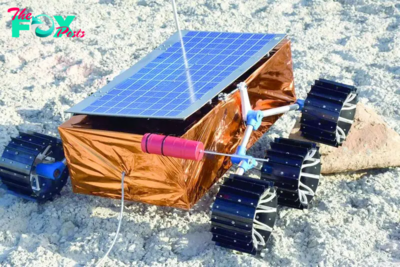Technology
China tests building Moon base with lunar soil bricks | The Express Tribune
China is expected to push forward in its quest to build the first lunar base on Friday, launching an in-space experiment to test whether the station's bricks could be made from the Moon's own soil.
Brick samples will blast off aboard a cargo rocket heading for China's Tiangong space station, part of Beijing's mission to put humans on the Moon by 2030 and build a permanent base there by 2035.
It is a daunting task: any structure has to withstand huge amounts of cosmic radiation, extreme temperature variations and moonquakes, and getting building materials there in the first place is a costly procedure.
Constructing the base out of the Moon itself could be a solution to those problems, scientists from a university in central Wuhan province hope.
They have created a series of prototype bricks made of various compositions of materials found on earth, such as basalt, which mimic the properties of lunar soil.
Slivers of those test bricks will be subjected to a series of stringent tests once they reach the Tiangong space station.
"It's mainly exposure," said Zhou Cheng, a professor at Wuhan's Huazhong University of Science and Technology.
"To put it simply, we put (the material) in space and let it sit there... to see whether its durability, its performance will degrade under the extreme environment."
The temperature on the Moon can vary drastically between 180 and -190 degrees Celsius (356 to -310 degrees Fahrenheit).
Its lack of an atmosphere means it is subjected to large quantities of cosmic radiation as well as micrometeorites, while moonquakes can weaken any structure on its surface.
The exposure experiment will last three years, with samples sent back for testing every year.
Zhou's team developed their prototype bricks after analysing soil brought back by China's Chang'e-5 probe, the world's first mission in four decades to collect Moon samples.
The resulting black bricks are three times stronger than standard bricks, he said, and interlock together without a binding agent.
The team has also worked on the "Lunar Spider", a 3D printing robot to build structures in space, some of which are conical in shape.
"In the future, our plan is definitely to use resources on-site, that is, make bricks directly from the lunar soil, and then do various construction scenarios, so we won't be bringing the materials from Earth," said Zhou.
It's "an obvious thing to try" because using materials already on the Moon would be much cheaper, said Jacco van Loon, an astrophysicist at Keele University in Britain.
-

 Technology20h ago
Technology20h agoGet chronic UTIs? Future treatments may add more bacteria to your bladder to beat back harmful microbes
-

 Technology1d ago
Technology1d agoThe Gap Between Open and Closed AI Models Might Be Shrinking. Here’s Why That Matters
-

 Technology1d ago
Technology1d agoDenver Broncos on verge of giving fans faster internet as it installs Wi-Fi 6E at stadium
-

 Technology2d ago
Technology2d agoAsking ChatGPT vs Googling: Can AI chatbots boost human creativity?
-

 Technology2d ago
Technology2d agoUnderstanding Retrieval-Augmented Generation (RAG): The Future of AI-Powered Information Retrieval and Response Generation
-

 Technology4d ago
Technology4d agoCanva down: Users report major disruptions in editing, downloading images | The Express Tribune
-

 Technology4d ago
Technology4d agoUranus: 243 years later, new discoveries challenge what we thought we knew | The Express Tribune
-

 Technology4d ago
Technology4d agoTaurid meteor shower set to light up UK skies over next two nights | The Express Tribune



























